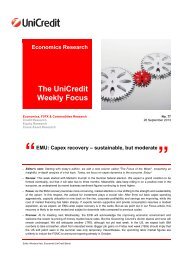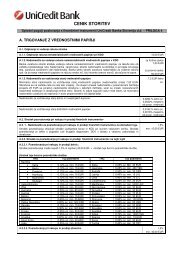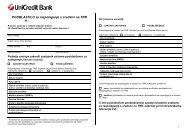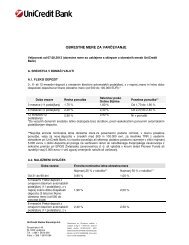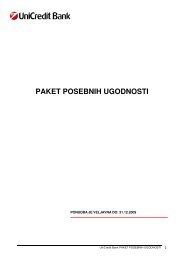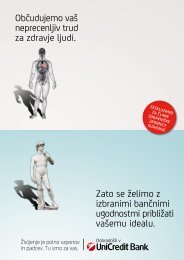Letno poroÄilo 2009.pdf - UniCredit Banka Slovenija dd
Letno poroÄilo 2009.pdf - UniCredit Banka Slovenija dd
Letno poroÄilo 2009.pdf - UniCredit Banka Slovenija dd
- No tags were found...
You also want an ePaper? Increase the reach of your titles
YUMPU automatically turns print PDFs into web optimized ePapers that Google loves.
Business ReportEconomic Environment in 2009The recession, which started in the last quarter of 2008, exceededeven the most pessimistic forecasts. Economic growth, whichamounted to 6.8 % on the annual level in 2007, dropped to 3.5 %in 2008. This was particularly due to the last quarter, when, for thefirst time during this recession, Slovenia recorded negative growth(-0.8 %) on an annual basis. Growth forecasts in Slovenia for 2009,which were still positive in autumn 2008, quickly started to turnnegative in January 2009. In the first quarter of 2009, Sloveniarecorded an -8.2 % drop in growth at the annual level, in the secondquarter it had already reached -9.2 %, and in the third quarter, -8.3 %. The final estimate for the total economic growth in Sloveniafor 2009, prepared by the Institute of Macroeconomic Analysis andDevelopment (IMAD), is now -7.8 %, while forecasts for the comingyears are also very modest. The IMAD forecast for economic growthfor 2010 is 0.9 % , and for 2011, 2.5 %. Such forecasts do not bringsignificant relief, since the forecasted levels are close to the forecastof average growth in the EMU. On the contrary, in previous yearsSlovenia experienced considerably higher growth and when our goalwas a 2 percentage points higher growth than in the European Union(EU).in November 2009 it amounted only to 1.4 %. The growth rate,in regards to retail loans, is similar to that in 2008, whereby thatrate was already more than half below the year before. Housingloans grew by 15.8 % until November 2009, while the amount ofconsumer loans remained virtually unchanged. The balance sheetof the banking sector has changed considerably compared to 2007,especially in the choice of bank investments, where growth rate ofinvestments into securities increased considerably and growth ofbank credit activity to the non-banking sector decreased significantly.Volume of assets of the banking sector amounted to 6.8 % from thebeginning of 2009 until the end of November 2009, and the amountof profit before tax was lower by as much as 41 % compared to2008. Operational costs of the sector were lower in the period untilNovember 2009 than in the same period in 2008, and year-on-yearlabour cost growth did not exceed one per cent. Profitability of thebanking system amounted to 6.3 %, which is slightly more than halfof that in 2007 during the same period.The local stock exchange market (index SBI20) recorded 11.41 %growth in 2009, which was considerably lower than the growth onIMAD’S assumptions and international institutions’ forecasts for the economic growth in 2009 and 2010IMADSep 09IMFOct 092009 2010OECDNov 09<strong>UniCredit</strong>Dec 09IMADSep 09IMFOct 09OECDNov 09EMU (3.9) (4.2) (4) (3.9) 0.4 0.3 0.9 0.9Germany (4.8) (5.3) (4.9) (4.8) 0.9 0.8 1.4 2USA (2.8) (2.7) (2.5) (2.5) 0.9 1.5 2.5 1.8United Kingdom (4.7) (4.4) (4.7) (4.6) (0.3) 0.9 1.2 1.3Source: IMAD Autumn forecast (September 2009), <strong>UniCredit</strong> Group Friday notes<strong>UniCredit</strong>Dec 09The annual inflation level followed the trend of economic growth.From mid-2008 the monthly inflation rate began decreasing and inJuly 2009, at the year-on-year level, reached a negative level.A turning-point came in November 2009, when inflation, measuredaccording to HICP, increased considerably and reached 1.8 % atthe year-on-year level, and in December even 2.1 %, mainly dueto the energy price trends. Further growth of prices is expected in2010. IMAD foresees in its Autumn forecast that 2010 year-on-yearinflation will increase to 2.0 % at the end of the year, whereby theaverage inflation level in 2010 will amount to 1.5 %. In 2011, theinflation should rise to 2.7 % at the year-on-year level according tothis forecast.bigger global markets (DAX 19.5 %, DOW 15.6 %, FTSE 18.5 %).The volume of transactions at the Ljubljana Stock Exchange droppedby 29.7 % compared to 2008. Despite the considerable correction ofquotations in 2008, P/E ratio remains relatively high at 23.6, wherebyit is important that quoted Slovenian companies had, on average,bigger net profit losses than their EU competitors. Share of foreigninvestors at the Ljubljana Stock Exchange is 7.4 %.As early as 2008, the banking sector recorded a considerable dropin the growth of non-banking sector lending and thus indicated thefuture economic standstill. Growth of these loans amounted to asmuch as 40 % at the end of 2007; in 2008, we recorded a constantdrop in these levels (in October 2008 it dropped to 33 %), while<strong>UniCredit</strong> Bank · 2009 Annual Report 133



